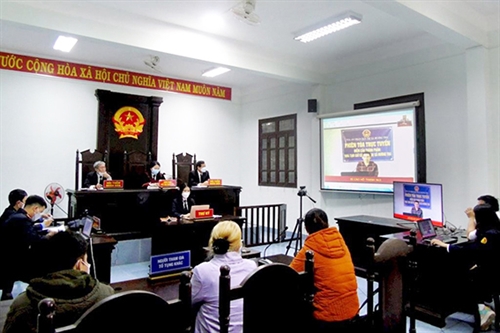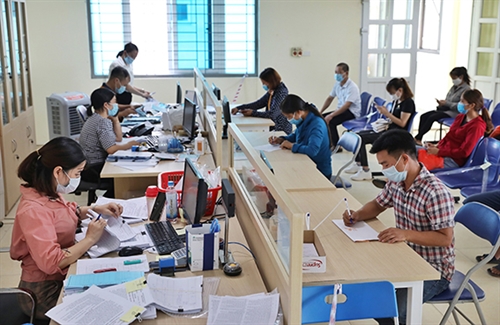Assoc. Prof., Dr. Nguyen Hoa Binh
Politburo Member
Secretary of the Central Party Committee
Chief Justice of the Supreme People’s Court
Accelerating the digital transformation in the court system and building e-courts are regarded as present urgent tasks which need to be concretized for early completion. They will bring an opportunity for Vietnam’s court system to consolidate the people’s trust in justice and improve its operational efficiency to meet requirements set forth in the Resolution of the 12th National Party Congress. The digital transformation and e-court building will greatly contribute to the success of the judicial transform strategy, thus helping Vietnam’s justice keep up with the development trend of the world’s progressive justice.
Understanding e-courts
At present, the rapid development of information technology has brought about numerous opportunities for improving effectiveness of the national governance and delivery of justice around the world. The Fourth Industrial Revolution and unceasing development of digital technology have been substantively changing operation of the court system. Reality shows that many countries have attached great importance to application of information technology as a basis for improving court operation efficiency. In that context, Vietnam’s court system has adopted the policy to intensify the application of information technology, thereby getting the best of advantages offered by Industry 4.0 to build e-courts - an important task set forth in the judicial reform strategy for the court system.
Building the e-court system is the process of partially transferring court operation from the real space to the digital space, essentially covering performance, optimization and development on digital platforms of such activities as internal court governance, publicization of court operation, provision of public judicial services to the people, provision of support utilities to improve work performance of holders of judicial titles, connection and exploitation of databases of national digital platforms, especially performance of e-procedural activities.
E-courts will deliver enormous benefits for the court system, people and society.
Firstly, they will assist in improving productivity of courts. Most of procedural activities that have been carried out by the time-consuming and labor-intensive conventional methods will be automatically performed on digital platforms or online (from the stage of acceptance of requests for initiation of lawsuits or cases or receipt of case files to the stage of completion of settlement of cases). This will help improve the productivity of courts and save labor and time. It also serves as a solution to overcome difficulties and reduce workload pressure as the number of cases is on the rise while state payrolls have been downsized.
Secondly, they will enable judges to make more accurate judgments and rulings. Instead of making case files with reference to legal texts and performing procedural jobs in a manual manner, e-courts will, with artificial intelligence (AI) and big data, help judges and court staff process case files more quickly and effectively, especially in searching relevant legal texts and court precedents as well as cases with similar legal circumstances. Furthermore, AI might make it possible to find a “virtual assistant” to help judges in making lawful, quick and accurate judgments and rulings.
Thirdly, they will help save labor, time and cost for the people. The people will no longer need to show up at courtrooms during working hours but may proceed with their procedural rights and obligations (filing of lawsuit initiation petitions, provision of evidence and proofs, etc.) anywhere and anytime via digital platforms. They may also use online services of referring to previous judgments, analyzing and predicting proceeding results, etc., before deciding whether or not to initiate lawsuits, thus saving time and cost for being involved in lawsuits and disputes that need to be settled by the court.
Fourthly, they will facilitate the humane settlement of unexpected circumstances in proceedings. The e-court system will enable involved parties, witnesses and lawyers who, for such reasons as epidemics, illnesses, or travel or economic difficulties, cannot personally show up at courtrooms to participate in court hearings. Particularly for cases of sexual violence against children, the child victims will not be summoned to courtrooms but have their testimonies taken electronically in order to avoid their direct contacts with defendants, protect their privacy and prevent them from suffering subsequent psychological trauma, or personality and honor injuries.
Fifthly, they will guarantee transparency of operation of the court system. As publicity and transparency are primary requirements of the adjudication process, the e-court system is expected to raise publicity and transparency of all adjudicating activities, progress and results of court hearings, thereby enabling the people to supervise the whole process of settling cases or lawsuits and raising the people’s trust and confidence in courts.
Sixthly, they will work in improving the management and supervision capacity of the court system. E-courts will serve as an effective tool to facilitate the management and direction by the Supreme People’s Court over the entire court system and by higher-level courts over lower-level courts. Particularly, it will help raise the capacity to supervise the progress of acceptance of cases and lawsuits for settlement within the court system, thus increasing transparency and preventing negative practices.
Seventhly, they will help save operation expenses. With the intensive application of information technology, e-courts are expected to help save 10-15 percent of operation expenses for the court system. Virtual organization of conferences, seminars and professional training courses will allow more judges and court staff nationwide to participate in such events for improvement of their professional skills and exchange of experience without having to pay travel and accommodation expenses.
 |
| An online court hearing at the hall of the People’s Court of Huong Tra town, Thua Thien-Hue province__Photo: https://tapchitoaan.vn/ |
International experience in building e-courts
Building the e-court system has become a global trend. Reality shows that many developed countries, such as the US, Australia, Germany, Japan, the Republic of Korea, Singapore and China, have recorded great achievements thanks to their early application of information technology to building of e-courts, provision of administrative-judicial services, service of procedural documents, provision and receipt of evidence and proofs in electronic form, and holding of remote court hearings in replacement of conventional procedural activities.
The aforementioned countries’ courts have installed e-procedure software with modern functions to assist their populations in performing procedural activities on digital platforms (from filing of lawsuit initiation petitions and provision of evidence and proofs via the network to completion of court hearings). Such software also enables the people to supervise the progress of case or lawsuit settlement by the court, thereby helping raise their trust and satisfaction. Smart-procedure software has been applied to assist judges in the process of studying and settling cases (automatic compilation of case files; search for applicable legal texts; service of procedural decisions and rulings; verification of information; preparation of judgments, etc.). E-courts in these countries have helped reduce half of time required for case settlement and facilitated uninterrupted, timely and scientific management and direction of the court systems as well as management and professional training of judges[1]. Obviously, the application of information technology and building of e-courts have become an irreversible development trend of the court systems around the world.
Orientations for building the e-court system in Vietnam
Building the e-court system to perform and raise capacity for court governance on digital platforms
E-courts will be built to improve effectiveness of internal court governance on digital platforms (the system). The application of digital technology will enable courts to manage the following activities:
(i) Procedural activities: All procedural activities, from receiving lawsuit or case initiation petitions, accepting case files for settlement, assignment of tasks for case settlement to conclusion of the trial and making of judgments, will be automatically updated on the system. The system may, in addition to the functions of storing information and monitoring procedural activities, also give warnings and reminders for judges and administrators to prevent violations and errors (e.g., failure to serve procedural documents, expiration or breaches of procedure-conducting time limits, etc.)
(ii) Staff management: All information about court staff, from their recruitment and appointment and their working periods, will be automatically updated on the system. Software for supervision and evaluation of judges (based on the set of evaluation criteria) will be developed and applied. On a biannual or annual basis, this software will evaluate judges and send notices to court leaders to serve the management work, and concurrently to each judge so that he can know his ranking and try to improve it.
(iii) File management and archive: All original records and files will be managed and archived on big data warehouses of digital platforms, with priority given to digitalization of procedural files for the immediate future. Regular updating of archived records and files on digital platforms will help keep them intact for a long term with minimum labor and cost, which is decisive to AI-based management, use, analysis and forecast activities.
(iv) Staff training and further training: Information technology will facilitate holding of virtual conferences, seminars and training courses in the court system and also help increase the number of participants and save time and cost. The enormous amount of knowledge archived in the e-court system will serve as a precious information source assisting court staff in self-training and jurisprudential research activities. Training activities carried out on digital platforms will guarantee productive, quality and efficient training of staff and students in the court system nationwide.
(v) Statistical work: Application of digital technology aims to serve the preparation of regular and irregular reports, analysis and processing of statistical data to meet higher management requirements. The digital transformation will help form the big data stores of courts, serving the review of trial practices, detection of legal loopholes, violations, modus operandi of crimes, and evaluation of effectiveness of the violation and crime prevention and combat.
(vi) Management of physical foundations, equipment and finance in the court system: This is aimed at strictly and lawfully managing and efficiently using them, and preventing waste or loss.
Building the e-court system to provide better public legal services to the people
One of important objectives of e-courts is to serve the people and provide them with modern, convenient and cost-effective public legal services, particularly the following:
* Sending and receipt of lawsuit initiation petitions, documents and evidence; issuance, service and notification of documents of courts by electronic means. After the filing is completed, the system will provide receipt codes for the people and enterprises to monitor the process of case acceptance and settlement by the court. The issuance, service and notification of documents of courts may be carried out via personal electronic devices, e.g., smartphones and personal computers, in a quick and convenient manner.
* Online registration for issuance of copies of judgments and documents in case files: By this, agencies, organizations and people will not have to show up at courtrooms and may request issuance of copies of judgments and documents in case files anywhere and anytime.
* Online payment of court fees and fines: Via the system, proceeding participants may pay court fees and fines online in accordance with law or judgments without having to come to State Treasury offices.
* Search for information about cases, including notices of acceptance of cases or matters for settlement; decisions on assignment of judges to accept cases or matters; schedule of holding court hearings or meetings, proceedings, and other information.
* Provision of judgments for tried cases to the people for reference and analysis of similar legal circumstances so as to make reasonable and lawful legal decisions and considerations. On that basis, the people may exercise their civic rights and perform their civic obligations, such as the right to initiate lawsuits, make protests or file denunciations, and their effective participation in judicial supervision activities.
* Provision of legal consultancy services: AI will be applied to “build” virtual legal consultants to help the people search applicable legal texts and answers to questions about case settlement procedures. Other online public services of courts will be further developed and online interaction channels will be expanded for the people to participate in monitoring settlement and trial activities of courts and send their feedback to courts.
Building the e-court system to help judges improve working efficiency and quality
Building e-courts with intensive application of information technology and AI will help judges settle cases more accurately and reduce workload pressure. The improvement of judges’ performance is extremely important since the quality of court operation depends largely on judges’ work. Recently, the Supreme People’s Court has put virtual assistants into use to provide smart services to judges. As personal secretaries of judges, virtual assistants are programmed to be knowledgeable about laws and professional operations of the court and can work around the clock and conveniently communicate with judges in spoken or written languages via smartphones or personal computers. They can assist judges in:
- Introducing relevant legal frameworks for case settlement, including laws, ordinances, decrees and circulars, and citing specific applicable articles and clauses thereof;
- Introducing similar legal circumstances summed up by the Judicial Council of the Supreme People’s Court from trial practices and providing answers in response to these circumstances;
- Introducing relevant court precedents;
- Introducing like legally effective judgments. Judgments will be introduced for reference in the following priority order: cassation judgments of the Judicial Council of the Supreme People’s Court, cassation judgments of the three superior people’s courts, and other judgments;
- Working out case settlement plans, creating and managing e-case files, digitalizing and arranging records and files by type of document of cases for convenient study, managing work, and providing warnings, notices and task reminders;
- Automatically creating model legal documents in accordance with procedure laws (summons, temporary detention decisions, decisions to bring cases to trial, etc.); writing certain parts of judgments. This will help reduce their workload by around one-third compared to the conventional working process;
- Analyzing data, verifying information and detecting errors in court judgments and rulings. The system will make it possible to deeply analyze case information, make cross-reference and checking of case information, help verify evidence and proofs, detect omitted proceeding requests and citation errors, analyze judgments and correct technical errors, detect logical errors in documents which are hard to be found visually;
- In subsequent stages, virtual assistants can make relatively accurate analyses, reasoning and legal consideration suggestions, thus helping judges make prompt and uniform decisions; and,
- Encrypting and posting court judgments and rulings on court portals.
Building the e-court system for organizing remote procedural activities
The core of the building of e-courts is digital transformation of procedural activities in order to establish a new proceeding-conducting method based on digital platforms. Countries with advanced justice and technology have enacted e-proceedings acts and conducted many procedural activities (from the stage of case acceptance to completion of case settlement) on digital platforms. Vietnam’s procedure laws also provide for electronic and online proceedings at the stage of trial. At the recent second session, the 15th National Assembly adopted a resolution permitting the holding of remote court hearings. However, the regulations currently in force are not sufficient to bring into the fullest play the potential of information technology applied in judicial activities.
Procedural activities that can be remotely carried out include filing of lawsuit or case initiation petitions, provision of evidence and proofs and making of statements and declarations; payment of court fees and fines for violations; holding of reconciliation meetings in civil cases and dialogues in administrative cases; first-instance and appellate trial of criminal, civil and administrative cases; holding of meetings to settle civil matters (requests for recognition of parents for children, limitation of parental rights to children, termination of child adoption, etc.), making of copies of files and procedural documents and service and notification of procedural documents, among others.
Building the e-court system to contribute to raising publicity and transparency of court operation
Publicity is a substantive nature of adjudicating activities, aiming to guarantee the people’s right to access information and serving as an effective tool to control powers and to uphold responsibility of judges in exercising judicial rights. With such significance, publicity of court operation is a core principle enshrined in the Constitution. The Supreme People’s Court’s Circular 01/2017/TT-TANDTC dated July 28, 2017, contains specific provisions facilitating the media’s participation in and reporting on court hearings[2]. E-courts are expected to help further improve publicity and transparency of court operation. On digital platforms, the court system will have to properly make public the following seven domains:
(i) The system of laws, regulations, resolutions of the Judicial Council of the Supreme People’s Court, court precedents, guiding texts, and legal questions and answers, thereby facilitating the search for legal documents.
(ii) The assignment of court personnel to accept cases for settlement. The publicity of the task assignment will help create a mechanism for monitoring task assignment for case settlement within the court system as well as exercise of rights and performance of obligations by involved parties and proceeding participants (filing of requests, additional provision of evidence).
(iii) The progress of acceptance and settlement of cases, thereby enabling the people and court leaders to supervise and urge judges to complete the case settlement within law-specified time limits.
(iv) The trial process at court hearings (except cases subject to in-camera proceedings) for public observation, thus contributing to improvement of the sense of law observance.
(v) Trial results, including legally effective court judgments and rulings for the people’s surveillance and reference. Publicity of trial results also helps uphold responsibility of judges for improving trial and judgment quality.
(vi) The process and results of judgment execution, thereby creating conditions for the people and society to supervise the judgment execution and ensure thorough delivery of justice.
(vii) The process and results of the consideration for sentence exemption or commutation. Accordingly, the whole process and results of the consideration for sentence exemption or commutation, suspension or postponement of judgment execution, and conditional release of inmates will be made public on digital platforms for the people’s monitoring.
Building the e-court system for connection with other digital platforms
Building e-courts is also aimed at connecting with digital platforms of the country and ministries and sectors, such as the National Public Service Portal, the National Population Database, and databases of the General Statistics Office and the Supreme People’s Procuracy, etc. The connection among digital platforms will enable courts to exploit the national databases to better perform their tasks and at the same time share and optimize utilities of these databases in the court system so as toward building a digital society and digital economy and raising effectiveness and efficiency of the national administration.
Important tasks to be performed in the coming time
In order to successfully build the e-court system, it is required to have comprehensive solutions, necessary resources and drastic administration, with the immediate focus on the following five major tasks:
Firstly, formulating a general strategy for digital transformation in the court system
The Party and the State consider the development of science and technology an important driving force for national growth. Politburo’s Resolution 52-NQ/TW dated September 27, 2019, on a number of guidelines and policies for proactive participation in the Fourth Industrial Revolution, lays a special stress on the task of accelerating the digital transformation as a political foundation for building the e-court system. In the process of international integration, the Supreme People’s Court has also committed to completing the building of and operating e-courts by 2025. This requires the Supreme People’s Court to expeditiously formulate and implement a general strategy for digital transformation in the court system through 2025, with orientations toward 2030. The strategy must set forth specific objectives, targets, requirements and tasks, thereby establishing the court system’s adequate awareness about the importance of the digital transformation and building of the e-court system. This is an inevitable development of the national digital flow and also brings about an opportunity for the court system to develop. The strategy should have a long-term vision and be flexible and adaptable to the rapid technology development so as to take short-cut approaches to state-of-the-art technologies to help save cost and time.
Secondly, improving legal documents
Smooth operation of the e-court system requires a complete and uniform legal framework adaptable to digital technology. Main legal grounds for e-courts include (i) the law on e-proceedings, (ii) the laws on information technology, digital technology and AI, and (iii) the law on organizational apparatus of courts and other proceeding-conducting bodies, not to mention other relevant regulations.
This legal framework should be improved toward allowing remote (online) performance of procedural activities, specifying e-evidence, providing scientific bases and legality of software for restoration of e-evidence, cyber security, defining organizational structure, functions, tasks and powers of persons and entities conducting e-proceedings, and role and right of information technologists to participate in proceedings, etc.
Thirdly, developing a modern digital infrastructure
Information technology and digital technology infrastructure facilities play an important role in the development of the e-court system. The Supreme People’s Court should formulate a scheme on assurance of physical foundations for e-courts. The scheme aims at equipping digital infrastructure facilities including terminal equipment, stable high-speed transmission lines, big data storage centers and operation centers; establishing digital platforms for e-court operation and AI-based virtual assistants for different tasks and operations of e-courts; and designing a program on training of personnel for management, operation and utilization of e-courts. As this scheme will need a large investment amount, it must be implemented according to an appropriate schedule for immediate, medium-term and far future periods, depending on economic and technological development level of the country. Funding sources will be mobilized from the state budget, foreign donors and all economic sectors. At the same time, technological equipment for the e-court system must meet requirements on modernity, security, safety, convenience and short-cut approach.
Fourthly, developing information technology human resources
Human resources constitute an important factor decisive to the success of the digital transformation and building of the e-court system. Development of human resources for practical operation of e-courts should focus on training personnel for digital technology management, operation and application, including information technology and digital technology engineers, judges, judicial title holders and court staff at all levels, and providing necessary knowledge to people whose cases or matters are brought to court. An apparatus for operation of the digital technology system should be established from the Supreme People’s Court to provincial-level courts. Judges and court staff should be retrained to be knowledgeable about e-courts and adapt to the cyber environment[3].
Fifthly, intensifying international cooperation
To date, many countries in the region and the world have made big strides in building their e-courts. Vietnamese courts, though having actively performed the task of building the e-court system and recorded some initial achievements, should cooperate with foreign partners in application of the world’s digital technology advances to court operation with a view to building Vietnamese e-courts, thus helping save time, labor and cost and prevent limitations. International cooperation will enable the Vietnamese court system to get access to financial sources, e.g., official development assistance, and experience of the developed countries with modern e-court models, and eventually establish digital infrastructure connections for the ultimate goals of building e-courts and realizing digital transformation in the court system.-









